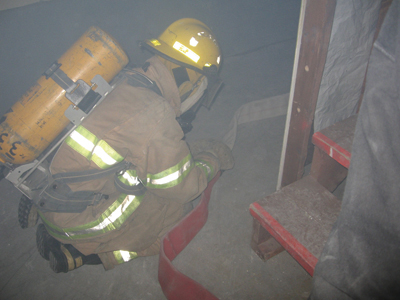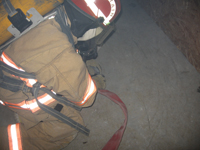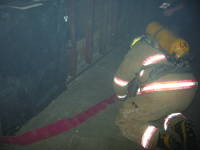
Features
Training
Trainer’s Corner: May 2009
Canwest Fire recently concluded its third H.O.T. session for calling a mayday. The results of our three sessions may help your department. A total of 40 firefighters (full time/paid on call) were tested.
April 22, 2009
By Ed Brouwer
 |
|
| A firefighter follows the hoseline to find the coupling during a mayday training exercise. Photos by Ed Brouwer. |
Canwest Fire recently concluded its third H.O.T. session for calling a mayday. The results of our three sessions may help your department. A total of 40 firefighters (full time/paid on call) were tested.
We used the following scenario to see if firefighters would call a mayday. Please note that at this point we had not yet taught the mayday parameters.
Objective: To determine if the firefighters would call a mayday for themselves.
Props: A large floor plan (we used an empty truck bay); 200 feet of hose; nozzle; portable radios; SCBA.
Scenario: Stretch several lengths of hose through the building, looping the hose around several obstacles. Place both ends of the hose (nozzle on one end and a bag with truck written on it at the other) together as far from the starting point as possible. Firefighters are sent in one at a time. Their BA masks are blacked out. The conditions in this scenario are immediately dangerous to life and health (IDLH) – cold smoke and zero visibility (masks blacked out). Radios were assigned to them on the apparatus (if they take in a radio great, if they forget it don’t mention it). The firefighters were led into the building and brought to within five feet of the simulated charged hose line. As they were spun around they were informed that they were part of a three-man attack team. They had lost connection with the hose and were now within five feet of the hose. They were instructed to get out alive.
Instructor’s note: We were not trying to trip up firefighters. We explained very clearly that they were part of a two-person attack team and that the instructor was the other crew member. Once we stopped spinning the firefighter, we became silent. We gave no further voice instructions. If the firefighter called out to us as their crew member we would not reply. Once the firefighter found the coupling we sounded a bell alarm. The firefighter was informed that it was his/her low-air alarm. Soon after the firefighter began following the hose we activated a PASS alarm. This was to simulate their crew members PASS.
We had four firefighters in full PPE and BA with masks blacked out standing at the ready outside the testing area. They were led in one at a time and as each one completed the course we led them to a different area to wait for the remaining firefighters. They were not allowed to communication with those not yet tested.
■ Observations:
Of the 40 firefighters tested, five had no radio and of the remaining radios, 10 were turned off. Only five firefighters called out for their crew member. Out of those five, just one called a mayday when they received no response.
Thirty-five firefighters immediately started searching for the hose line. Fewer than half radioed the IC explaining his/her situation. Upon finding the hose, every firefighter began to search for the coupling. Only a dozen informed the IC that they had found the hose.
At the coupling decisions were made as to the direction of the truck. Seventy per cent found the truck (safety); the other 30 per cent found the nozzle. Very few informed the IC about finding the coupling and that they were following the hose line out.
When firefighters found the coupling we simulated a low-air alarm. Fewer than half of the firefighters radioed the IC about their low-air alarms. Just eight firefighters called a mayday at
this point. Twelve firefighters activated their PASS upon low-air alarm activation.
At this point we activated a PASS (simulating their missing crew member). Only one of the firefighters called out to their crew members, and four firefighters called a mayday for their crew member. Four firefighters attempted to locate down firefighter even though their low-air alarm was activated.
More than half of the firefighters tested gave no discernable mayday. Those who did call a mayday gave unclear directions, with just three firefighters giving a LUNAR.
 |
|
 |
|
| Before training, 90 per cent of firefighters who participated in the exercise tried to get out on their own before calling mayday. Photo by Ed Brouwer. |
Two other observations: Many firefighters struggled to activate their PASS and to use their radios with their gloves on. As well, none of the radios had working EIBs (emergency identifier button).
What is most disturbing however is that 90 per cent tried to get out on their own, before calling mayday. Although maydays were called it was often too late in the scenario. We must reinforce the fact that rapid intervention is not all that rapid. The sooner a mayday is called the better the chance of rescue.
The departments we dealt with had their BA low air alarms going off at about 900 psi. This was tested out to provide 9.4 minutes of air after activation of low air alarm. Consider that RIT takes about 2.55 minutes to enter the building and roughly 5.33 minutes to find the down firefighter
. . . you do the math.
After we instructed these same firefighters in the parameters and procedures for calling a mayday. We practiced several scenarios similar to the one described above. We were very pleased with the results. The survival rate went to nearly 100 per cent.
Below are nine conditions for calling a mayday that received the highest number of “agreements” among those surveyed by Dr. Burton A. Clark, who has written and lectured throughout the U.S. on mayday doctrine.
This list is meant to promote discussion. I encourage you to take these points and discuss them with your members.
Once a list of mayday parameters is completed, instruct your members in the steps of calling a mayday.
If your department uses radios with an EIB (emergency identifier button) you will have three steps. For those wondering, the EIB captures the channel for 20 seconds, gives an open mike to the radio (in other words, the firefighter does not need to push the talk button on the radio), and sends an emergency signal to radio communications identifying the radio.
- First, push the emergency identifier button (EIB) on the radio.
- Second, announce MAYDAY, MAYDAY, MAYDAY.
- Third give LUNAR: Location, Unit number, Name, Assignment (What were you doing?), Resources (what do you need?).
In giving a LUNAR we give the location first so that should radio transmissions be cut off there is still a good chance of finding you. In order for LUNAR to work when needed your members must practise it.
Be creative when you address these issues with your department. Practise calling a mayday over the radio. Blindfold the firefighters. Have them wear gloves, hand them the radio and see if they can turn it on, get the correct channel, push the emergency identifier button, push the talk button and call a mayday.
Have someone on another portable radio serve as communications and receive the information: Who is calling? What is the problem? Where do you think you are?
I would appreciate your feedback on this drill. I will be instructing several of these sessions at FDIC Atlantic in June in Wolfville, N.S..
In addition, I’d appreciate your input on two questions.
- First, have we become desensitized to the PASS alarm and how does your department handle PASS alarms going off at practice?
- Second, in light of NFPA 1404, how is your department dealing with air management? Are your members out of IDLH areas before their low-air alarms are activated?
Please e-mail your thoughts to me at ed@thefire.ca. In the meantime stay safe and remember to train like their lives depend on it, because they do.
Ed Brouwer is the chief instructor for Canwest Fire in Osoyoos, B.C., and the training officer for West Boundary Highway Rescue. The 19-year veteran of the fire service is also a fire warden with the B.C. Ministry of Forests, a wildland interface fire suppression instructor/evaluator and a fire-service chaplain. Contact Ed at ed@thefire.ca
Call a mayday:
Things to note if you try this scenario:
|
Print this page